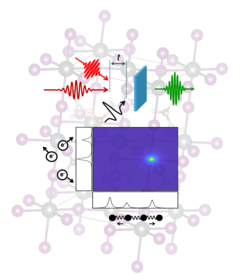2D Electron Phonon Correlation Spectroscopy

In condensed matter systems, electrons do not exist as independent entities but strongly interact with their neighboring nuclei and other electrons. The interplay among the structural and dynamic atomic arrangements, charge, and spin degrees of freedom give rise to exotic properties – which cannot be accounted for by free electrons in a static lattice or even the Fermi liquid picture. These interactions also define the complexity of the materials and make it challenging to truly understand their properties.
The two-dimensional electron-phonon correlation (2D EPC) spectroscopy, recently developed from us, allows for the direct experimental identification of a specific vibrational mode which is coupled to electronic degrees of freedom. In this 2D EPC spectroscopy, a series of light-matter interactions were designed to measure the quantum coherence resulting from the dynamic coupling between electronic and phonon states. The induced nonlinear polarization of a material system contains information that can be converted into a 2D map with each axis representing a specific (vibration and electron) degree of freedom.
With this novel approach, we systematically study how such mode-specific electron-phonon couplings behave across structural or electronic phase transitions, under various strain/ temperature/ chemical pressure conditions, and in the reduced dimensionality for the solid systems (e.g. hybrid perovskites, transition metal dichalcogenides, and molecular Mott insulators). Also, the mechanism of non-radiative relaxation of electronically excited materials is expected to be revealed by this technique.
